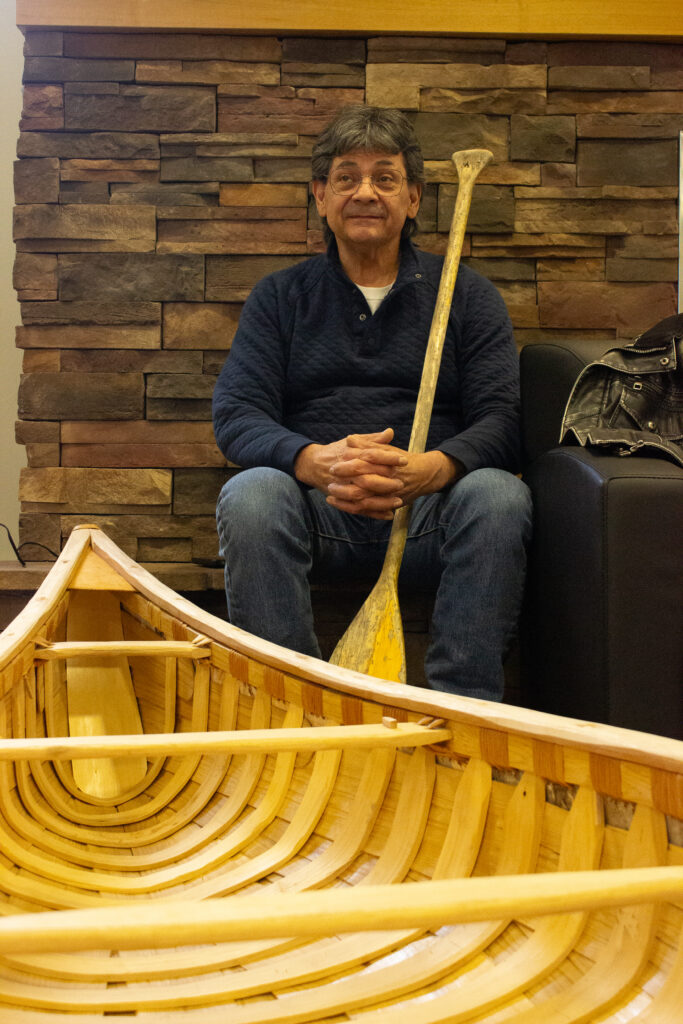Algonquin Elders hold Wigwam Welcoming Ceremony

By Kaitlin Sylvester
The Hastings Highlands Public Library hosted a welcoming ceremony on Feb. 3 to formally welcome a Wigwam to the space. At 11 a.m., Algonquin Elders and community members, led by Jimmy Green gathered to celebrate the installation of a traditional wigwam as part of a community-led reconciliation effort. The ceremony began with a welcoming drum song and a sage smudge led by two Algonquin Elders.
Next to the wigwam was a traditional birch bark canoe built by Chuck Commanda, donated to the library by Katherine Cannon. The ceremony was led by Jimmy Green and two Algonquin Drummers. More than an art installation; the wigwam symbolizes a larger movement toward Indigenous placemaking. Library CEO, Wendy Keating emphasized the importance of art and libraries in this process, saying “placemaking is about creating space, both physically, and in policy – for ceremony, teaching and community.”
While introducing the project, Green shed light on the different styles of housing, emphasizing teepees as traveling accommodations, whereas wigwams were intended as a more permanent structure. Wigwams are rooted in Indigenous cultures across Canada and are deeply connected to the environment and communal living. Wigwams are designed using wooden poles, like maple, which are bound together at the top with the use of natural binding agents like spruce roots. The initial structure is then reinforced with shorter wooden poles fitted in between the larger ones, creating a sturdy framework.
The wigwam at HHPL is currently just the poles, with plans to cover the exterior in the coming weeks. Green and Keating outlined plans to engage local students to decorate large strips of birch bark which will then be used to cover and insulate the wigwam. “We're going to set up a bunch of programs for kids and hopefully get some Elders into [the library] tell stories about what the village was like, like 75 years ago, 80 years ago” said Green when talking about his long term plans for the structure.
Green also touched on the historical significance of birch bark in Algonquin cultures. Beyond covering wigwams for warmth, birch bark played a vital role in various aspects of Algonquin First Nations' lives. It has been used in the making of containers, artistic designs, and for centuries it has served as the basis for making lightweight canoes.
The birchbark canoe has a profound cultural legacy in Canada. Initially a crucial means of transportation for Indigenous peoples, in recent years it has become a symbol of Canada's cultural identity. Canoe craftsman Commanda highlighted the shift from dugout style canoes to birch bark canoes approximately 4,500 years ago. Birch bark canoes weigh a mere 30 pounds, have proved to be versatile and capable of carrying nearly a ton due to their effective weight distribution.
Commanda also spoke about the traditional methods of building canoes, confirming that the canoe residing in the library is made entirely of tree material. These materials, Commanda said, “were used a thousand years ago and continue to be essential today.” The canoe building process uses white spruce roots, ironwood ‘nails' and spruce resin to ensure waterproofing. Commanda says they chose ash wood for the frame as “ash is a nice hard wood that will hold its shape over a long period of time.”
Unfortunately, the environmental challenges posed by the emerald ash borer have severely impacted the availability of this hardwood in the region. Green and Commanda discussed this invasive species, saying its impact on the local environment cannot be understated. Arriving in North America in the early 1990s, has affected the abundance of ash trees killing up to 99% of ash trees once it arrives in a region.
While ash trees have declined in the region, birch bark remains abundant and is revered for its versatility, both in construction and in plant-based medicines. Several attendees at the event spoke about their personal affinity to birch trees, sharing stories of connection or appreciation to the papery bark that is prevalent across the Hastings Highlands. Guests shared stories of tapping birch trees for water, using the leaves and bark as remedies for various skin-related conditions, and even using birch bark as makeshift “megaphones,” to imitate the call of female moose.
Cannon, an Algonquin Elder, expressed her excitement about sharing the birch bark canoe with the community, emphasizing the traditional importance of the bark among the Algonquin peoples. Cannon spoke about the educational value of the event, calling it “a significant step toward reconciliation.”
“We're hoping that the librarians will help to teach the community what is needed,” Cannon said “not just how to build things like this, but the purpose of building them and why they are important to our culture.” Green also emphasized the importance of storytelling, saying he “hoped to bring [Algonquin] Elders into the space to share stories of the history of the area.”
Keating echoed this sentiment saying, “[today] had a really joyful, open feeling that we want to keep going. Even from the children there's this willingness or wanting to learn.” Keating and Green both hinted at future collaborations between HHPL and the Algonquin community, indicating the wigwam would be included in upcoming programming. “Of course we have other resources, like books and things to support education,” Keating added, “but [we think] listening to the stories of the elders is the best way to keep the culture alive.”
The Wigwam Welcoming Ceremony at HHPL was a move towards reconciliation, education, and community building. Green and Commanda showcased the rich cultural heritage of the Algonquin people through the traditional methods of canoe and wigwam building while HHPL secured its role in creative placemaking, becoming a vital space for preserving and sharing these invaluable stories.
|
